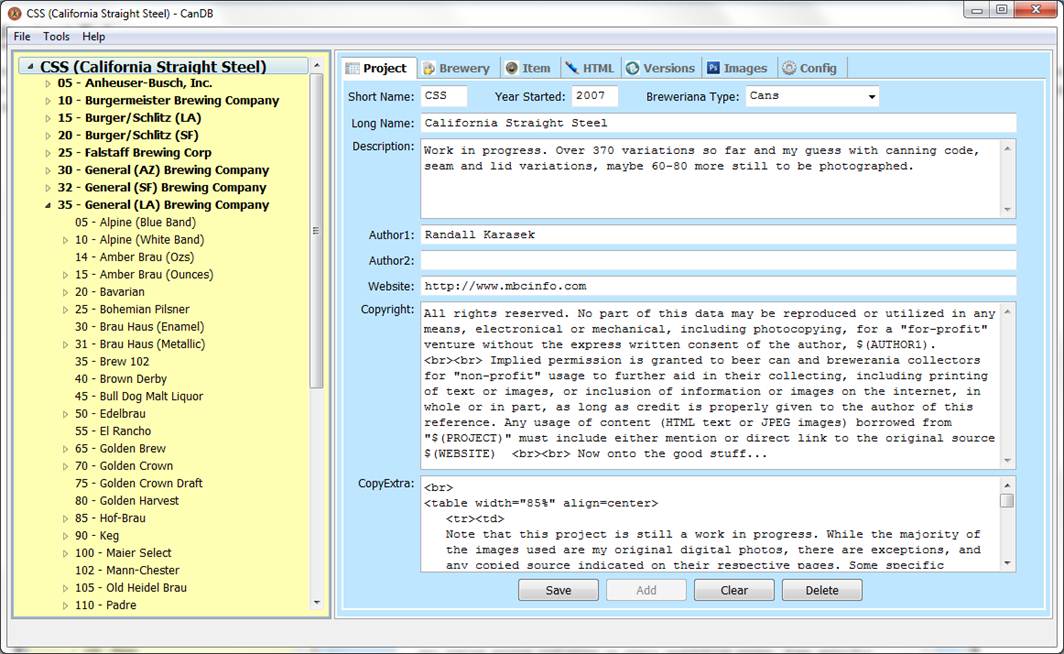![]() Project
Tab
Project
Tab
The main window of "CanDB" consists of two panels, a navigator tree on the left, a set of tabbed folders on the right. The navigator is a tree-like structure showing a hierarchy of projects, breweries within a project, items within a brewery, and optional variations for an item. As you add, change, or remove data from the tabs, the tree will automatically be updated. If you make selections from the tree, the appropriate tab will be displayed. Selecting a given tab such as Project, Brewery, Item, etc will display the folder for that tab.

CanDB version 2.0 introduces the concept of “Breweriana Type”. The default will be “Cans”, but there are now built in project types for “Coasters”, “Sheets”, “Trays” and the all inclusive “Other”. Simply select from the upper right combo box to choose your breweriana type and “Save”. Depending on the project type, the data import, item tab, configuration details, and generated HTML will adjust to the specific type. For example, for trays and coasters there are two images (front and back) and the HTML pages show fewer but larger images. For beer cans, the item tab includes many entry options for book references. For the generic “other”, there are user configurable lists and entry names.
A given project can have just a single breweriana type and content. If you want to enter both cans and trays, please create two projects, one of type Cans, the other of type Trays.
Your first step using CanDB will be to define a "project". What type of items you choose to include in a project is entirely up to you, with the above example showing the "California Straight Steel" project configuration. HTML is partitioned by projects, so easy to copy just a selected project's HTML/images to web site, disk, backup, etc. Data for a given project consists of the following properties. While you should give some consideration for the project details, any of these values can be changed at a later time and simply regenerate the HTML.
|
Property |
Description |
|
Short Name |
This will be a 2 to 5 character "acronym" for the project, used as both folder name and included on many of the generated HTML pages. For example, MBC, CSS, ABC, etc. This value must be unique between projects, and you will not be allowed to Add/Save until the values are unique. |
|
Long Name |
The full name for the project, typically used for Title of the generated HTML. Must be unique across projects. |
|
Description |
Full description of the project. This will be used in the generated Table of Contents as well as the Title attribute used inside the HTML, and thus pulled from most searching engines such as Google, Yahoo, etc. |
|
Year Started |
Year the project was started. This is used as starting year for generated Copyright statements. |
|
Author1 |
Optional author name #1. If you are producing a composite, you should at least receive credit for doing the work and hours, days, weeks, months and years of taking photographs! |
|
Author2 |
Optional author name #2 if you are working on the composite with someone else. |
|
Website |
Optional web site to be listed in the generated HTML. If you don't plan to web host content, leave this blank |
|
Copyright |
While most generated HTML pages will include a short form of Copyright added to the bottom of each page, recommendation is to include an explicit Copyright HTML page, with full details of what you consider important in the statement. This can contain text plus HTML tags (e.g. if you want blank lines use the <br> element, bold use <b>, underline <u>, etc). Also note the usage of the above properties, with CanDB substituting project values into the placeholders for $(AUTHOR1), $(AUTHOR2), $(PROJECT) and $(WEBSITE). The default MBC and CSS Copyright statement is the default value for this field, and you can edit/replace with whatever is appropriate for your project. |
|
CopyExtra |
This includes any extra HTML which should be written under the Copyright table. This is any HTML, and an example can be viewed from the CSS Copyright page. Optional field, default is empty. |